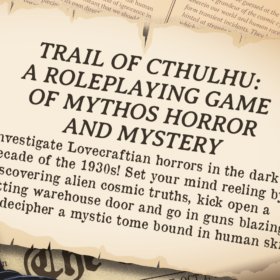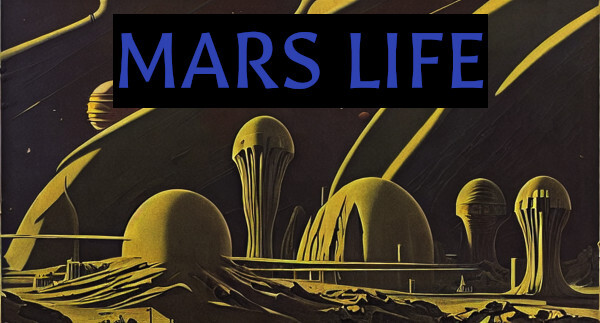News, See Page XX
See Page XX: Mars Life (An EZ One-Shot Scenario)
A column about roleplaying
By Robin D. Laws
In the last installment of this column, I laid out the rules for a simple, super low-prep system for casual one-shot games. Let’s follow that up with a look at the scenario I ran for the Pelgranes present in London on the night before Dragonmeet in 2022.
Mars Life
The players take the roles of personnel on Terraforming Station 71B, one of many dotted across the Martian surface. They plant, tend and monitor aerators, plant-fungal hybrids that look somewhat like enormous ferns. Eventually these genetically engineered organisms, in concert with the others at the many other counterpart stations, will fully bloom, flooding the planet with oxygen and rendering its atmosphere breathable.
The characters work for the MarsLife corporation, which has just undergone a semi-hostile change of ownership. Rumors of cost-cutting measures swirl, breeding employee disquiet.
Character Generation Questions
Create characters by posing the following questions.
What is your name?
What is your specialty on the station?
Are you good at this?
If not, what are you good at?
Why did you come to Mars?
Second round
Why does the character to your left distrust you?
Are you aware of their distrust?
The second round choices in the example questions from last month’s rules post created cohesion within the group. These questions sow the seeds of inter-PC conflict.
You could also run this with Skulduggery, but here the objective was low prep and low demand of player focus. And unlike that game, running with EZ One-Shot gave the players the option of deciding to work through their established tensions to solve the central problem together.
Not that this happened.
Opening Scene
The scene opens in the installation’s media room, where all employees gather for an all-hands meeting. An artificial intelligence commences the meeting together, introducing itself as the Estimation Liquidation Operations Node. It announces that austerity measures are indeed being implemented. Starting with the next drone drop in 72 hours, the installation will no longer be supplied with sufficient oxygen pills for all personnel. Instead, the Estimation Liquidation Operations Node will jointly monitor team activities during this period. Team members should expect both their individual performance and the necessity of their roles to be thoroughly evaluated during this period. However, the Estimation Liquidation Operations Node believes in the importance of collective input, and will therefore entertain reports from employees. These should focus on candidates who might best be designated for redundancy and therefore stricken from the list of oxygen recipients.
The Estimation Liquidation Operations Node does not say, unless asked, that no extraction awaits those removed from the pill list. Employees objecting to their termination may do so according to the terms spelled out in their contracts, by lodging a mediation request from its governing jurisdiction, the state of Delaware.
After answering whatever other questions the team members pose, the Estimation Liquidation Operations Node withdraws into observation mode, leaving the team members to respond as they see fit.
A Reveal for Later
A Martian colony equivalent of an urban legend holds that certain of the first wave of settlers disappeared. Just as WWII pilots complained of sabotage by gremlins, MarsLife workers blame these legendary lurkers, the Murphs, when things go inexplicably awry at their stations. Only a few take this seriously. No one could have survived, much less had and raised children, without a steady supply of oxygen pills. The corporation treats this whole yarn as a joke, holding an annual Murph Day where HR-approved revels occur across their installations and campuses.
The Murphs really do exist—or they might, if your plot requires a twist. Some exiles from the early settlements underwent a mysterious process of rapid evolution, developing the ability to breathe and gain sustenance from carbon dioxide. They might show up to offer a chance of survival to characters who wish to depart the station. A quick little blood ritual and they’ll be inhaling CO2 like born Murphs.
—
That’s less than I actually wrote up before running the scenario, which aside from the character question list and name of the AI was stored in my head.
Players selected the following specialties: Environmental Closure (Plumbing), Botany, Morale, Radiation Control, Medical Officer, and Janitor. Two of them specified that they were not good at their jobs: the Morale and Medical officers, who were actually skilled at Survival and Health Bureaucracy, respectively.
The group accepted the heavy nudge toward PVP and, prompted by their distrusts toward another, soon split up into smaller units to plot against one another.
As the Morale Officer was obviously created to be everyone’s first target, he fittingly wound up earning a promotion from the Estimation Liquidation Operations Node. Under the new corporate org chart he became Commandant of the installation.
As we reached the third act, Ken, playing the Radiation Control Officer, asked if he could spend a token to buy a plot development. So naturally the station sustained a hit from a deadly ion storm. Sure, it benefited Ken’s character but it also escalated the stakes. Always bring an apple for the GM, kids.
Not wanting to end our convivial evening on a bummer note, I did elect to have a Murph appear. He showed up stuck in an air duct after trying to sneak in to steal food.
In a surprise act of heroism, the Medic, who the Morale Officer had included on the essential personnel list, nonetheless elected to cede his oxygen pills to one of the slated cast-offs. He went off to join the Murphs, fulfilling his grandfather’s dream that he might become a true explorer.
The episode ended with a crane shot of the exiled employees gathered among their new Murph comrades, the entire vast throng armed for war against the corporation.
Your group, should you play this, might reject the PVP to bring about an entirely different conclusion. However the likelihood that it goes roughly as described above increases according to the amount of Riesling on the table.



